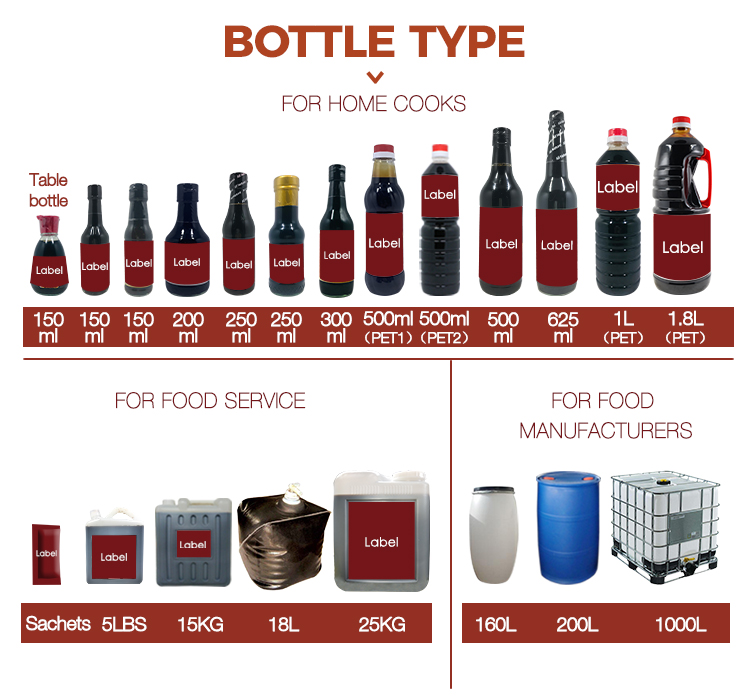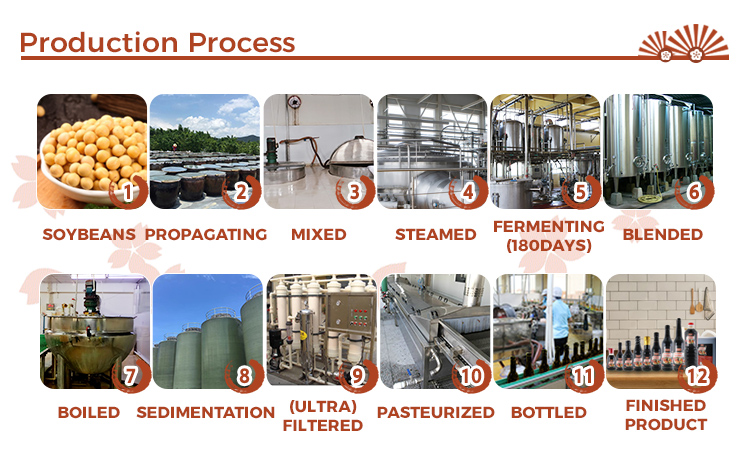TSY or Custom Brands
| Availability: | |
|---|---|
| Quantity: | |








Parameters About TSY Japanese Sushi Soy Sauce
| Flavor | Salty and a little sweet, delicious, fragrant and smooth |
| Ingredient | Soy bean,Water,Salt,Wheat Flour,Sugar,Caramel (E150C) ,Yeast Extract, Monosodium Glutamate (E621) |
| Serving Suggestion | It is mainly used for dipping sushi, sashimi, etc |
| Nutrition information typical values per 100g | Energy 211kJ/51Kcal Protein 10.9g Total fat 0g Carbohydrate 1.5g Sodium 7248mg |
| Shelf Life | 24 months |
| STORAGE: | Keep at room temperature and moisture proof storage. Please closed After opening use,and store in dry cool place. |
| Certificate | HACCP, BRC, IFS, HALAL, KOSHER, ISO |
The packages of Japanese sushi soy sauce usually come in small bottles or fish-shaped containers. Traditional soy sauce brands like Kikkoman offer specially designed bottles for sushi, featuring a convenient pour spout for dipping. Some packages may also include individual packets or sachets for takeout or on-the-go use.

Parameters About TSY Japanese Sushi Soy Sauce
| Flavor | Salty and a little sweet, delicious, fragrant and smooth |
| Ingredient | Soy bean,Water,Salt,Wheat Flour,Sugar,Caramel (E150C) ,Yeast Extract, Monosodium Glutamate (E621) |
| Serving Suggestion | It is mainly used for dipping sushi, sashimi, etc |
| Nutrition information typical values per 100g | Energy 211kJ/51Kcal Protein 10.9g Total fat 0g Carbohydrate 1.5g Sodium 7248mg |
| Shelf Life | 24 months |
| STORAGE: | Keep at room temperature and moisture proof storage. Please closed After opening use,and store in dry cool place. |
| Certificate | HACCP, BRC, IFS, HALAL, KOSHER, ISO |
The packages of Japanese sushi soy sauce usually come in small bottles or fish-shaped containers. Traditional soy sauce brands like Kikkoman offer specially designed bottles for sushi, featuring a convenient pour spout for dipping. Some packages may also include individual packets or sachets for takeout or on-the-go use.

This specification of Japanese Sushi Soy Sauce are cost-effective.

SPECIFIATION PER CTN | BOTTLE TYPE | CTNS/20'GP |
150ml*12btls/box*4boxes | Glass bottle | 1010 |
150ml*24btls | Table bottle | 1855 |
200ml*24btls | Glass bottle | 1550 |
250ml*24btls | Glass bottle | 1550 |
300ml*12btls | Glass bottle | 1550 |
500ml*12btls | Glass bottle | 1550 |
625ml*12btls | Glass bottle | 1330 |
1000ml*12btls | Plastic bottle | 1224 |
1.86L*6jar | Plastic jar | 1400 |
5L*4jar | Plastic jar | 756 |
8L*2jar | Plastic jar | 1150 |
18L*1bag/box | Faucet soft bags | 1008 |
15kg*2drum | Plastic drum | 700 |
25kg*1drum | Plastic drum | 800 |
160L*1drum | Plastic drum | 100 |
200L*1drum | Plastic drum | 80 |
1000L*1drum | Plastic drum | 20 |
* If you have other needs, please consult us.

This specification of Japanese Sushi Soy Sauce are cost-effective.

SPECIFIATION PER CTN | BOTTLE TYPE | CTNS/20'GP |
150ml*12btls/box*4boxes | Glass bottle | 1010 |
150ml*24btls | Table bottle | 1855 |
200ml*24btls | Glass bottle | 1550 |
250ml*24btls | Glass bottle | 1550 |
300ml*12btls | Glass bottle | 1550 |
500ml*12btls | Glass bottle | 1550 |
625ml*12btls | Glass bottle | 1330 |
1000ml*12btls | Plastic bottle | 1224 |
1.86L*6jar | Plastic jar | 1400 |
5L*4jar | Plastic jar | 756 |
8L*2jar | Plastic jar | 1150 |
18L*1bag/box | Faucet soft bags | 1008 |
15kg*2drum | Plastic drum | 700 |
25kg*1drum | Plastic drum | 800 |
160L*1drum | Plastic drum | 100 |
200L*1drum | Plastic drum | 80 |
1000L*1drum | Plastic drum | 20 |
* If you have other needs, please consult us.

Japanese sushi soy sauce, also known as shoyu, is a condiment that adds flavor to sushi and various other dishes. However, it is essential to note that soy sauce is relatively low in nutrients. Here are the main components of Japanese sushi soy sauce:
1. Sodium: Soy sauce is high in sodium, which is primarily responsible for its salty taste. High sodium intake should be moderated as excessive consumption can be detrimental to health, especially for those with high blood pressure or certain health conditions.
2. Protein: While soy sauce does contain some protein, the amount is relatively small and not a significant source of protein in the diet.
3. Amino acids: Soy sauce contains essential amino acids, such as glutamic acid and aspartic acid, which contribute to its umami flavor.
4. Carbohydrates: Soy sauce contains a small amount of carbohydrates, mainly in the form of simple sugars.
5. Iron: Soy sauce contains a small amount of iron, but it is not a significant source of this essential mineral.
Overall, while soy sauce can add flavor to dishes, it is not a significant source of nutrients, and its high sodium content should be consumed in moderation. If you are looking for essential nutrients, it is best to focus on a well-balanced diet that includes a variety of whole foods.
Producing Japanese sushi soy sauce in TSY Foods can offer several key benefits:
1. Cost-Effectiveness: China often has lower production costs, which can lead to more affordable soy sauce, making it economically advantageous for both manufacturers and consumers.
2. Scalability: TSY Foods vast infrastructure and manufacturing capabilities allow for large-scale production, ensuring a consistent and ample supply of sushi soy sauce.
3. Technological Expertise: TSY Foods has advanced food processing technologies, which can contribute to high-quality production and efficient processes.
4. Export Opportunities: With our well-established trade networks, TSY Foods can facilitate the distribution of Japanese sushi soy sauce to various international markets.
5. Ingredients Availability: China is a major producer of soybeans, a key ingredient in soy sauce, which can potentially reduce sourcing and supply chain challenges.
6. Customization: TSY Foods can tailor the soy sauce taste and private lable to meet specific flavor profiles or packaging requirements.
Japanese sushi soy sauce, also known as shoyu, is a condiment that adds flavor to sushi and various other dishes. However, it is essential to note that soy sauce is relatively low in nutrients. Here are the main components of Japanese sushi soy sauce:
1. Sodium: Soy sauce is high in sodium, which is primarily responsible for its salty taste. High sodium intake should be moderated as excessive consumption can be detrimental to health, especially for those with high blood pressure or certain health conditions.
2. Protein: While soy sauce does contain some protein, the amount is relatively small and not a significant source of protein in the diet.
3. Amino acids: Soy sauce contains essential amino acids, such as glutamic acid and aspartic acid, which contribute to its umami flavor.
4. Carbohydrates: Soy sauce contains a small amount of carbohydrates, mainly in the form of simple sugars.
5. Iron: Soy sauce contains a small amount of iron, but it is not a significant source of this essential mineral.
Overall, while soy sauce can add flavor to dishes, it is not a significant source of nutrients, and its high sodium content should be consumed in moderation. If you are looking for essential nutrients, it is best to focus on a well-balanced diet that includes a variety of whole foods.
Producing Japanese sushi soy sauce in TSY Foods can offer several key benefits:
1. Cost-Effectiveness: China often has lower production costs, which can lead to more affordable soy sauce, making it economically advantageous for both manufacturers and consumers.
2. Scalability: TSY Foods vast infrastructure and manufacturing capabilities allow for large-scale production, ensuring a consistent and ample supply of sushi soy sauce.
3. Technological Expertise: TSY Foods has advanced food processing technologies, which can contribute to high-quality production and efficient processes.
4. Export Opportunities: With our well-established trade networks, TSY Foods can facilitate the distribution of Japanese sushi soy sauce to various international markets.
5. Ingredients Availability: China is a major producer of soybeans, a key ingredient in soy sauce, which can potentially reduce sourcing and supply chain challenges.
6. Customization: TSY Foods can tailor the soy sauce taste and private lable to meet specific flavor profiles or packaging requirements.